CSU FarmBot Heralds Future Urban Agriculture on Campus
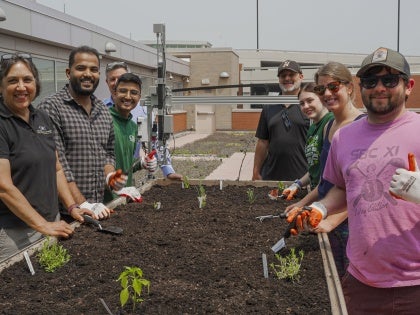
CSU on the Cutting Edge of Technology: New FarmBot has endless possibilities when it comes to cultivating a healthy living
Cleveland State University recently unveiled a one-of-a-kind garden that can be controlled from anywhere in the world via an app.
It has the potential to be a major game changer on campus—and beyond.
The newly installed FarmBot, located on the CSU Recreation Center’s green roof, is much like a regular garden you might see, but looks are deceiving. It is controlled by a robotic farming machine and corresponding software. FarmBot aims to “create an open and accessible technology aiding everyone to grow food and to grow food for everyone.”
By utilizing the FarmBot app, movement commands can be accessed, you can see your crop in an instant, turn the lights on for a nighttime harvest and even water your plants, from anywhere in the world.
The agriculture industry is experiencing a remarkable revolution through the integration of technology like FarmBot (specifically robotics) which is paving the way for advances in efficiency, sustainability and productivity. Robotic technologies are already streamlining agriculture—from crop planting, to harvesting and maintenance.
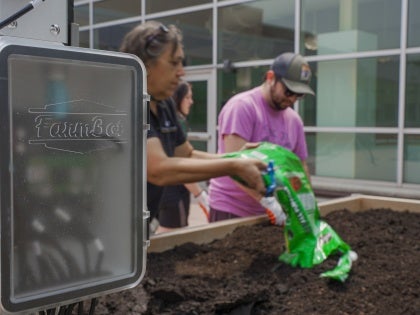
Machine learning will ultimately give farmers the ability to make more informed decisions in maximizing crop yields and protecting them from weather pattern challenges. It’s not a stretch to see a future where autonomous drones equipped with sensors are used for crop surveillance, detecting diseases, optimizing irrigation and more—all programmed with algorithms to handle everything from seeding to weeding, reducing the need for pesticides in the process.
But we’re getting ahead of ourselves here. Judy Ausherman (left) is Associate Professor of Health Education at CSU and has been hands-on in the process of bringing FarmBot to life (so to speak) on campus. She discussed the potential impact FarmBot could have on campus and how the program came together. According to Ausherman, it was nothing short of a miracle.
Cleveland State University: How did the idea for this come about?
Judy Ausherman: The FarmBot has really been a team effort. It is a classic story of like-minded people working together to make something happen.
It also was a case of many coincidences and being at the right place and time. The initial idea of the FarmBot came from a conversation Chris Rennison and I had after a meeting earlier this year. He is an avid blueberry farmer, and I became a master gardener in 2010... so we periodically have had conversations about gardening for many years when we see each other on campus. We talked about how it would be amazing to have gardening opportunities at CSU. Chris is also up on all the available new features and gadgets and showed me the link to the FarmBot.
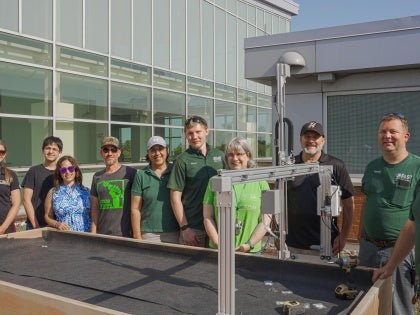
To revive the gardening concept on campus, I contacted Sara Continenza, a CSU alumnus and an amazing community organizer. She started Food Strong and has worked with many schools and communities setting up gardens. She came to campus, and we walked around visiting the FoodBank, Lift Up Vikes (LUV!), and looking at possible spaces on campus where we could propose how to start advocating for spaces or collaborating with others. Chris, Sara, and I also met with Dean Anglin [Levin College of Public Affairs and Education] to get ideas for planning.
Meanwhile, Katie Blodorn (far left) was working on promoting the “Shine Well” program. She talked to Emily Kullman, one of my colleagues and a faculty member in Exercise Science, about gardening. Emily said that Katie should contact me since I have been advocating for gardening on campus since Julka Hall was built in 2010 (in fact, a whole medicinal herb garden and square-foot gardening outside of the Health Science building were in the original blueprints).
Katie Blodorn contacted me, and I shared some ideas Sara and Chris mentioned. To make a long story short, Katie had a budget to order the FarmBot, so we discussed the idea with Tim Square, the superintendent of Grounds at CSU. We asked what would be the logistics that we would need to make this possible. The CSU grounds team supported the idea and described what it would take to make it a reality. Everyone had a part in making this happen, but Katie and Tim are keeping the logistics intact.
Katie ordered the FarmBot with the recreation center's budget and coordinated the operations. Tim worked with his team to construct and assemble the FarmBot. Chris & Sara gathered others in the community and CSU to support the concept. I contacted other faculty to see if other faculty and students would be interested in helping. So far, we have students, faculty, & staff from across the university pitching in. Katie Blodorn is keeping copious notes on who is volunteering, building, and moving this project along. It takes a CSU- and community village to get this launched.
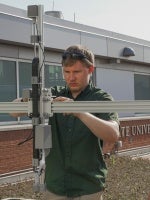
CSU: Are there any other colleges or universities doing this or is CSU the first?
JA: Not that we are aware of in this [Northeast Ohio] area. There is another university and community using it in Columbus.
CSU: What is the goal of having the FarmBot on campus?
JA: The initial goal is for individuals to become aware and motivated to eat healthier and know where their food comes from. As Sara always advocates what others have said “Food is Medicine” [and] other “Food is Medicine” campaigns have been around for years, but we have such a fascination with “a pill for every ill” we forget that good nutrition could solve many of the health-related problems in our society.
Another goal is to utilize the green roof for something functional. The "Shine Well" program created a great backdrop for this initiative. The FarmBot can also be a tool for collaboration since it crosses so many disciplines. Engineering, Urban Planning, Education, Health, Science (Botany), and Student Life. The two faculty in Botany who have signed on are Emily Rauschert and Andrea Corbett.
CSU: What kind of plants are going in?
JA: We are going to begin with planting herbs [with a] plan will be to expand, but herbs are versatile. Herbs that we grow will be used for infusing water at events. Also, Jason Harbert (from FoodStrong) is a chef and a CSU alumnus as well as a Coast Guard veteran will possibly assist in demonstrations in the Food Pantry on how to use herbs in cooking. We will also rely on our expert Botanists and Tim Square's expertise as well as others to guide us. We plan to add other plants as students get more involved and possible build more FarmBots or have engineering come up with other prototypes. President Laura Bloomberg said this probably would not be a problem after she saw the initial installation last week on the green roof.
CSU: Anything else you would like to add about this exciting initiative?
JA: This is only the beginning of what we would like to see at CSU on how to promote health living. The hope is to build an industrial greenhouse in the center of campus so we can have a year-round growing season. Tim Square said he has not only built these types of spaces but has managed commercial greenhouses, so CSU is in very competent hands. We also have faculty in the Botany department who are experts on how to grow healthy plants.
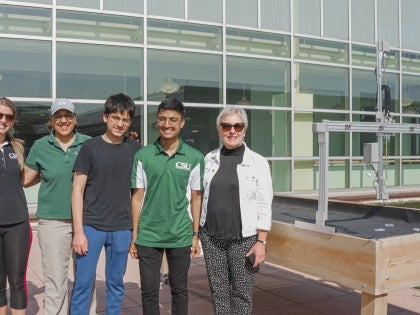
We are also hopeful that the greenhouse could be added as part of the CSU Master Plan.
We hope the FarmBot is a tool to not only get the conversation started, but a way for us to begin to collaborate in a way that makes us all recognize that we have more in common than we think... we all have to eat and hopefully find other ways to support each other in healthful ways. I am also encouraged that President Bloomberg (right), Provost Nigamanth Sridar, and members of our Board of Trustees support this initiative as well as many of the deans across campus. This is only the beginning of what is possible when we decide to work together on a common goal!